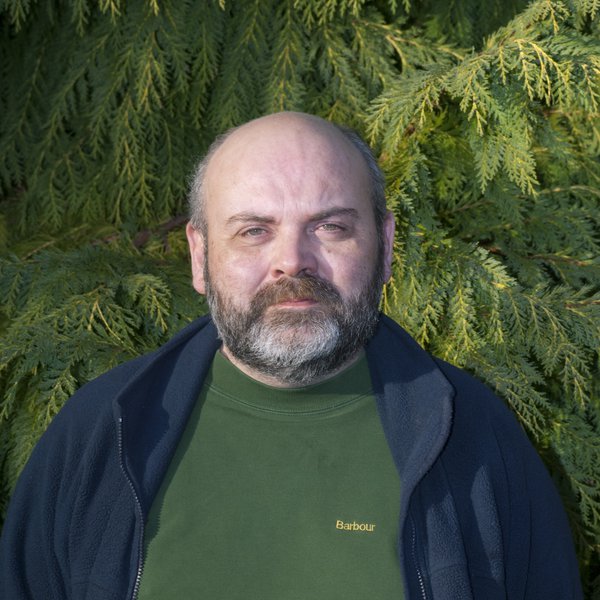Steve Hendry
BSc, PhD
BSc, PhD
Steve is responsible for diagnosing the causes of ill-health in trees and providing information and advice on tree diseases and their management via FR’s Tree Health Diagnostic and Advisory Service (THDAS).
He also carries out research on Chalara dieback of ash, focussed particularly on fruiting of Hymenoscyphus fraxineus and the dissemination of its spores in order to gain a better understanding of the factors influencing the current spread of the pathogen.
Steve gained a BSc in Botany from the University of Edinburgh in 1988 and was awarded a PhD by the University of Wales (Cardiff) in 1993 for his research into the pathology of environmentally-stressed beech trees. Following a period as a freelance botanist, he was employed as a wood scientist by the Building Research Establishment in 1995 and spent the next three years investigating and providing advice on various aspects of timber biodeterioration. Steve joined Forest Research as a forest pathologist in 1998.
UK representative on the EU COST Action FRAXBACK: “Fraxinus dieback in Europe: elaborating guidelines and strategies for sustainable management.

Forest Research
Northern Research Station
Roslin
Midlothian EH25 9SY
UK
The root and butt rot programme investigates biological and chemical methods of controlling the disease in commercial conifer crops
Delivering resilient forests – Managing biotic threats – Advice and support for pest and disease management
Advisory pathologist
Diagnosing the causes of disease in forest and amenity trees and providing advice to enquirers in the public and private sectors on tree health.
Understanding Biotic Threats – Surveillance and detection
Project Manager
Developing and applying techniques to aid the surveillance and detection fungal pathogens with a particular focus on trapping and quantifying spore inoculum of the ash dieback pathogen Hymenoscyphus fraxineus.
Previous projects
Forest condition survey
Monitoring the condition of British forests to meet international commitments to the EU and UN-ECE, and providing data on forest health to inform UK forestry policy and support the UK forestry industry.
Phytophthora diseases of broadleaf species
Conducting research on Phytophthora disease of alder in northern Britain and investigating the pathology and causes of alder dieback
Biological control of conifer root and butt rot
Project Manager
Investigating the potential for enhancing the resistance of Sitka spruce to root and butt rot caused by Heterobasidion annosum.
Tree Health Diagnostic and Advisory Service
Diagnostician
Diagnosing the causes of disease in forest and amenity trees and providing advice to enquirers in the public and private sectors on tree health.
Green, S., Elliot, M., Armstrong, A. & Hendry S.J. (2015). Phytophthora austrocedrae emerges as a serious threat to juniper (Juniperus communis) in Britain. Plant Pathology, 64: 456–466.
Pérez-Sierra, A., Gorton, C., Lewis, A., Kalantarzadeh, M., Sancisi-Frey, S., Brown, A. & Hendry S.J. (2015). First Report of Shoot Blight Caused by Sirococcus tsugae on Atlantic Cedar (Cedrus atlantica) in Britain. Plant Disease, 99: 1857.
Green, S., Hendry, S.J., MacAskill, G.A., Laue, B.E. & Steele, H. (2012). Dieback and mortality of Juniperus communis in Britain associated with Phytophthora austrocedrae. New Disease Reports 26, 2.
Redfern, D.B., Pratt, J.E., Hendry, S.J. & Low, J. (2010). Development of a policy and strategy for controlling infection by Heterobasidion annosum in British forests. Forestry 83 (2): 207-218.
Steele, H., Laue, B.E., MacAskill, G.A., Hendry, S.J. & Green, S. (2010). Analysis of the natural infection of European horse chestnut (Aesculus hippocastanum) by Pseudomonas syringae pv. aesculi. Plant Pathology, 59: 1005–101.
Hantula, J., Kurkela, T., Hendry, S. & Yamaguchi T. (2009). Morphological measurements and ITS sequences show that the new alder rust in Europe is conspecific with Melampsoridium hiratsukanum in eastern Asia. Mycologia 101(5):622-31.
Green, S., Hendry, S.J. & Redfern, D.B. (2008). Drought damage to pole-stage Sitka spruce and other species in north east Scotland. Scottish Forestry 62 (3): 10-18.
Hendry, S. J., Boddy, L. & Lonsdale D. (2002). Abiotic variables effect differential expression of latent infections in beech (Fagus sylvatica L.). New Phytologist, 155, 449-460.
Forestry Commission and Forest Research publications
Hendry, S. (2005). Monitoring of forest health in Britain: The Forest Condition Survey and Level I networks. Forest Research Annual Report & Accounts 2003-2004. The Stationery Office, Edinburgh.
Webber, J., Gibbs, J. and Hendry, S. (2004). Phytophthora disease of alder. Forestry Commission Information Note 6 (revised). Forestry Commission, Edinburgh.
Hendry, S. J., Poole, E. J. Craig, I. & Proudfoot, J. C. (2003). Forest Condition 2003. Forestry Commission Information Note 62. Forestry Commission, Edinburgh.
Hendry, S. J., Boswell, R. C. & Proudfoot, J. C. (2003). Forest Condition 2002. Forestry Commission Information Note 51. Forestry Commission, Edinburgh.
Cech, T. & Hendry, S.J. (2003). A review of diebacks and declines of alder (Alnus spp.) in Europe. In: Phytophthora Disease of Alder in Europe (ed. Gibbs, J. N., van Dijk, C. & Webber, J.) pp 15-24. Forestry Commission Bulletin 126. Forestry Commission, Edinburgh.
Hendry, S. J., Boddy, L. & Lonsdale D. (2002). Abiotic variables effect differential expression of latent infections in beech (Fagus sylvatica L.). New Phytologist, 155, 449-460.
Hendry, S. J., Boswell, R. C. & Proudfoot, J. C. (2002). Forest Condition 2001. Forestry Commission Information Note 46. Forestry Commission, Edinburgh.
Redfern, D. B. & Hendry, S. J. (2002). Climate change and damage to trees caused by extremes of temperature. In: Climate Change: Impacts on UK Forests (ed. M Broadmeadow) pp 29-39. Forestry Commission Bulletin 125. Forestry Commission, Edinburgh.
Hendry, S. J., Boswell, R. C. & Proudfoot, J. C. (2001). Forest Condition 2000. Forestry Commission Information Note41. Forestry Commission, Edinburgh.
Hendry, S. J., Lonsdale, D. & Boddy, L. (1998). Strip-cankering of beech (Fagus sylvatica): Pathology and distribution of symptomatic trees. New Phytologist, 140, 549-565.
Hendry, S.J., Boddy, L. & Lonsdale, D. (1993). Interactions between callus cultures of European beech, indigenous ascomycetes and derived fungal extracts. New Phytologist, 123, 421-428.
Hendry, S. J. (1993). Strip-cankering in relation to the ecology of Xylariaceae and Diatrypaceae in beech (Fagus sylvatica L.). Ph.D. Thesis, University of Wales, Cardiff, UK.
Trade journal and newsletter articles
Webber, J., Hendry, S., MacAskill, G. and Steele, H. (2004). Dutch Elm Disease Today. Farm Woodlands Newsletter 5 (Autumn 2004), 3.